2003 Oldsmobile Alero oil level
[x] Cancel search: oil levelPage 237 of 354
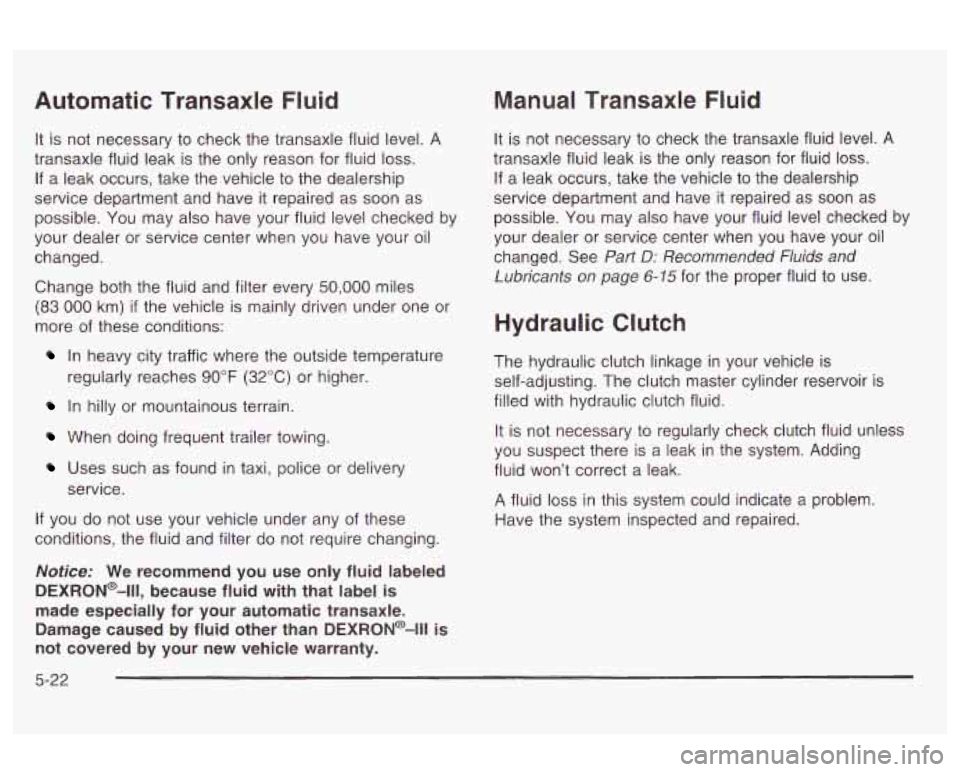
Automatic Transaxle Fluid
It is not necessary to check the transaxle fluid level. A
transaxle fluid leak is the only reason for fluid
loss.
If a leak occurs, take the vehicle to the dealership
service department and have it repaired as soon as
possible. You may also have your fluid level checked by
your dealer or service center when you have your
oil
changed.
Change both the fluid and filter every
50,000 miles
(83 000 km) if the vehicle is mainly driven under one or
more of these conditions:
In heavy city traffic where the outside temperature
regularly reaches
90°F (32°C) or higher.
In hilly or mountainous terrain.
When doing frequent trailer towing.
Uses such as found in taxi, police or delivery
service.
If you do not use your vehicle under any of these
conditions, the fluid and filter do not require changing.
Notice: We recommend you use only fluid labeled
DEXRQN@-Ill, because fluid with that label
is
made especially for your automatic transaxle.
Damage caused
by fluid other than DEXRON@-Ill is
not covered by your new vehicle warranty.
Manual Transaxle Fluid
It is not necessary to check the transaxle fluid level. A
transaxle fluid leak is the only reason for fluid
loss.
If a leak occurs, take the vehicle to the dealership
service department and have it repaired as soon as
possible. You may also have your fluid level checked by
your dealer or service center when you have your oil
changed. See
Part D: Recommended Fluids and
Lubricants
on page 6-15 for the proper fluid to use.
Hydraulic Clutch
The hydraulic clutch linkage in your vehicle is
self-adjusting. The clutch master cylinder reservoir is
filled with hydraulic clutch fluid.
It is not necessary to regularly check clutch fluid unless
you suspect there is a leak in the system. Adding
fluid won’t correct a leak.
A fluid
loss in this system could indicate a problem.
Have the system inspected and repaired.
5-22
Page 238 of 354
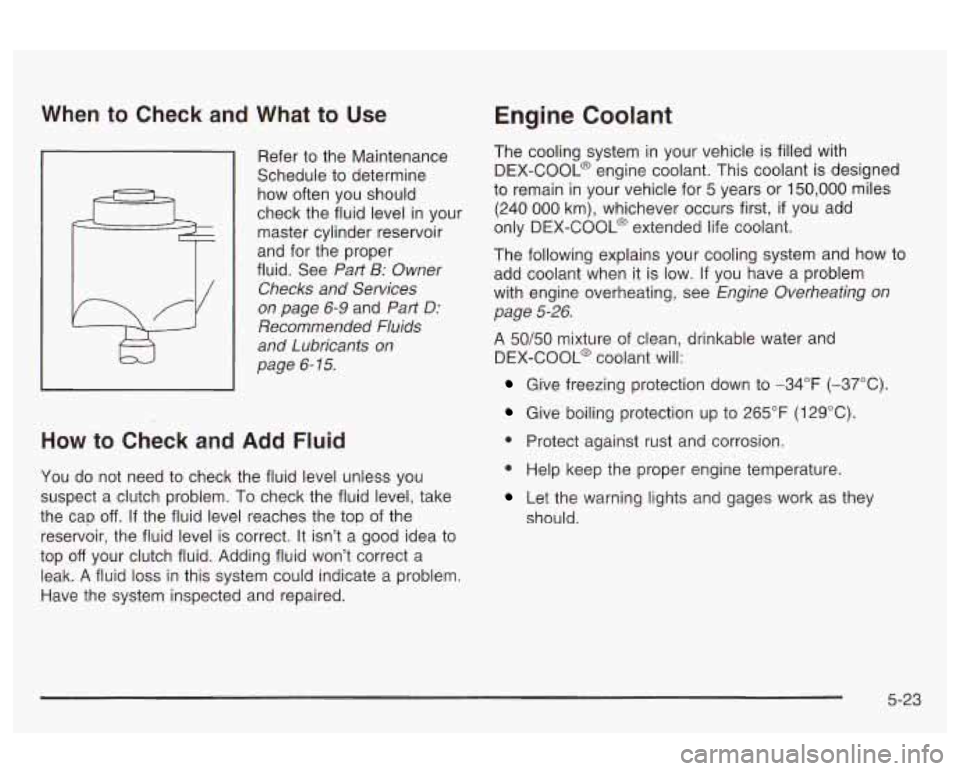
When to Check and What to Use
Schedule to determine
how often you should
check the fluid level in your
master cylinder reservoir
and for the proper
fluid. See
Part B: Owner
Checks and Services
on page 6-9 and Part D:
Recommended Fluids
and Lubricants
on
page 6- 15.
How to Check and Add Fluid
You do not need to check the fluid level unless you
suspect a clutch problem. To check the fluid level, take
the cap
off. If the fluid level reaches the top of the
reservoir, the fluid level is correct. It isn’t a good idea to
top
off your clutch fluid. Adding fluid won’t correct a
leak. A fluid loss in this system could indicate a problem
Have the system inspected and repaired.
Engine Coolant
The cooling system in your vehicle is filled with
DEX-COOL@ engine coolant. This coolant is designed
to remain in your vehicle for 5 years or 150,000 miles
(240 000 km), whichever occurs first, if you add
only DEX-COOL@ extended life coolant.
The following explains your cooling system and how to
add coolant when
it is low. If you have a problem
with engine overheating, see
Engine Overheating on
page 5-26.
A 50/50 mixture of clean, drinkable water and
DEX-COOL@ coolant will:
Give freezing protection down to -34°F (-37°C).
Give boiling protection up to 265°F (1 29°C).
@ Protect against rust and corrosion.
@ Help keep the proper engine temperature.
Let the warning lights and gages work as they
should.
5-23
Page 244 of 354
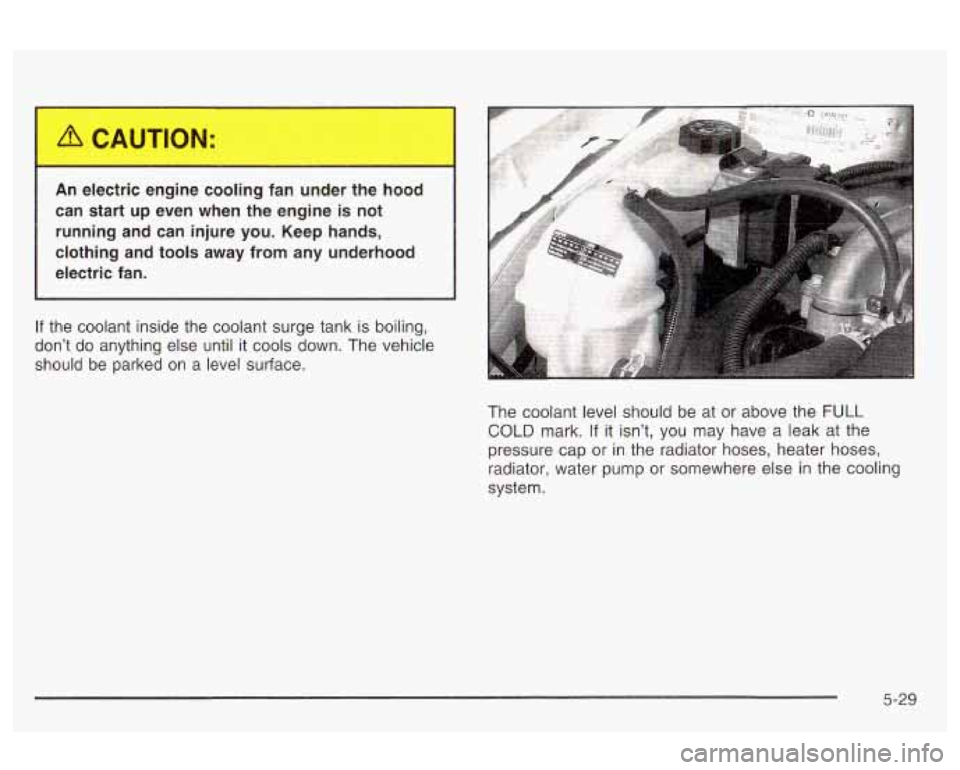
An electric engine cooling fan under the hood
can start up even when the engine is not
running and can injure you. Keep hands,
clothing and tools away from any underhood
electric fan.
If the coolant inside the coolant surge tank is boiling,
don’t do anything else until it cools down. The vehicle
should be parked on a level surface.
The coolant level should be at or above the
FULL
COLD mark. If it isn’t, you may have a leak at the
pressure cap or in the radiator hoses, heater hoses,
radiator, water pump or somewhere else in the cooling
system.
5-29
Page 254 of 354
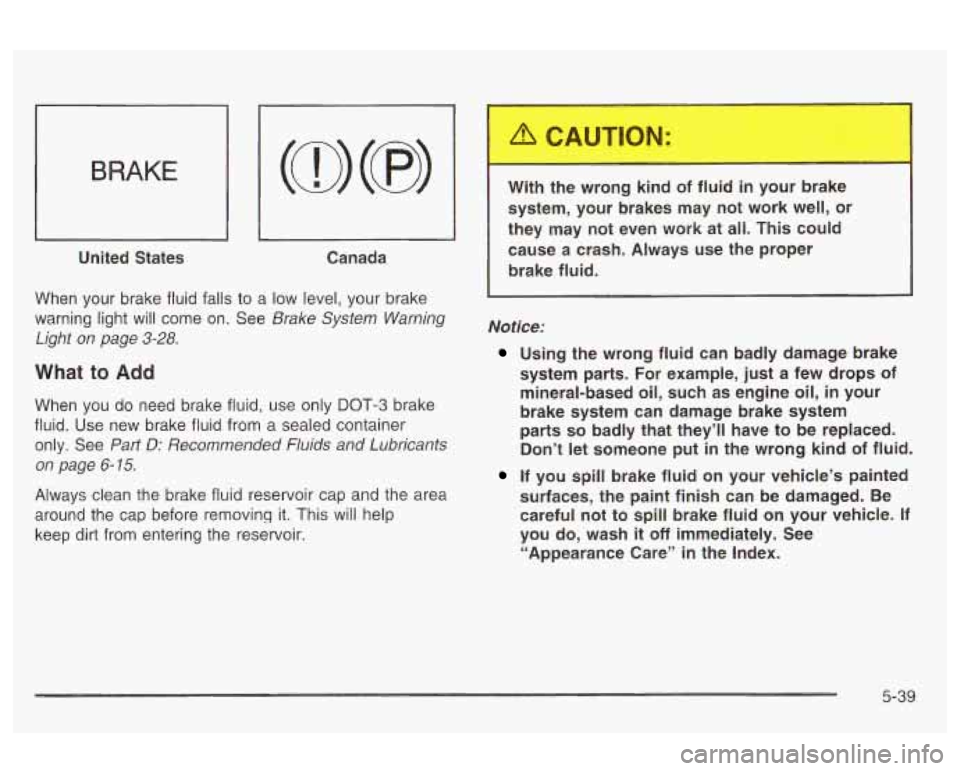
BRAKE
I I
United States
I I
Canada
When your brake fluid falls
to a low level, your brake
warning light will come on. See
Brake System Warning
Light on page
3-28.
What to Add
When you do need brake fluid, use only DOT-3 brake
fluid. Use new brake fluid from a sealed container
only. See
Part D: Recommended Fluids and Lubricants
on page
6- 15.
Always clean the brake fluid reservoir cap and the area
around the cap before removing it.
This will help
keep dirt from entering the reservoir.
\. ._h the wrong kinc~ luid in you1 re
system, your brakes may not work well, or
they may not even work at all.
This could
cause a crash. Always use the proper
brake fluid.
Notice:
Using the wrong fluid can badly damage brake
system parts. For example, just a few drops
of
mineral-based oil, such as engine oil, in your
brake system can damage brake system
parts
so badly that they’ll have to be replaced.
Don’t let someone put in the wrong kind of fluid.
If you spill brake fluid on your vehicle’s painted
surfaces, the paint finish can be damaged. Be careful not to spill brake fluid on your vehicle. If
you do, wash
it off immediately. See
“Appearance Care’’ in the Index.
5-39
Page 305 of 354
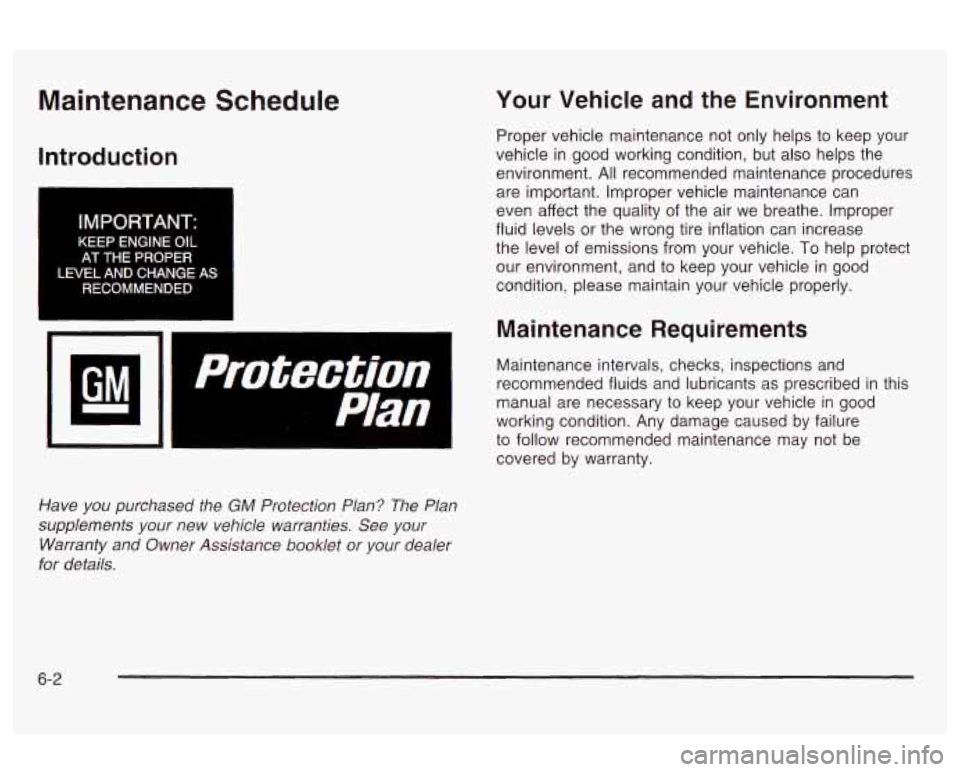
Maintenance Schedule
Introduction
IMPORTANT:
KEEP ENGINE OIL AT THE PROPER
LEVEL AND CHANGE AS RECOMMENDED
14
r
Have you purchased the GM Protection Plan? The Plan
supplements your new vehicle warranties. See your
Warranty and Owner Assistance booklet or your dealer
for details.
Your Vehicle and the Environment
Proper vehicle maintenance not only helps to keep your
vehicle in good working condition, but also helps the
environment. All recommended maintenance procedures
are important. Improper vehicle maintenance can
even affect the quality
of the air we breathe. Improper
fluid levels or the wrong tire inflation can increase
the level of emissions from your vehicle.
To help protect
our environment, and to keep your vehicle in good
condition, please maintain your vehicle properly.
Maintenance Requirements
Maintenance intervals, checks, inspections and
recommended fluids and lubricants as prescribed in this
manual are necessary to keep your vehicle in good
working condition. Any damage caused by failure
to follow recommended maintenance may not be
covered by warranty.
6-2
Page 308 of 354
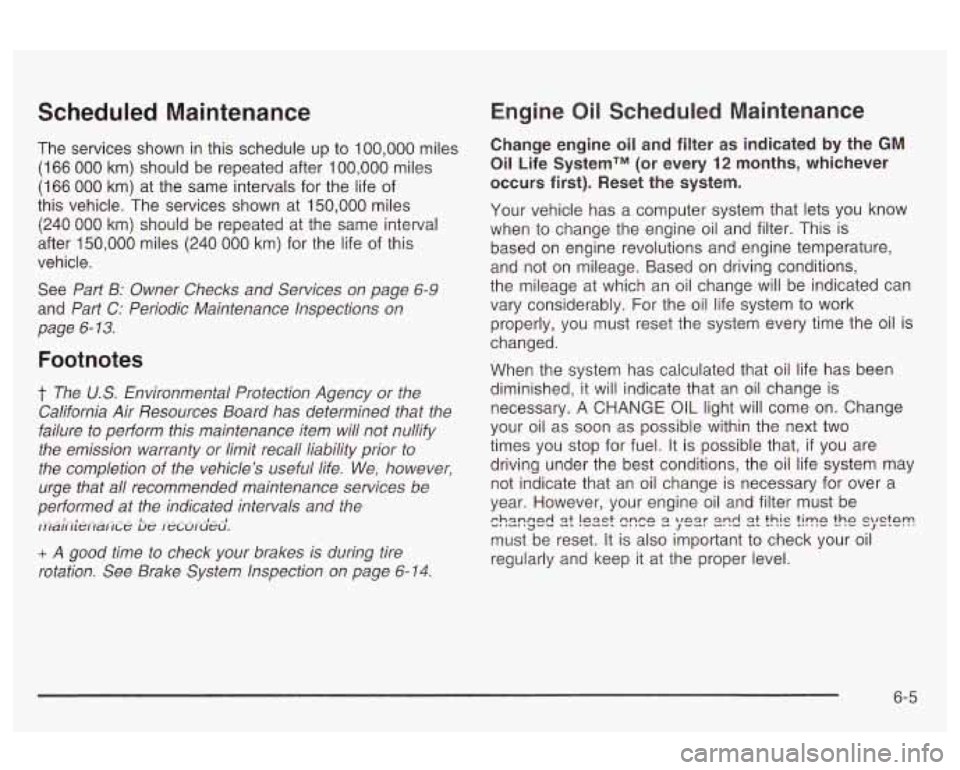
Scheduled Maintenance
The services shown in this schedule up to 100,000 miles
(1
66 000 km) should be repeated after 100,000 miles
(1
66 000 km) at the same intervals for the life of
this vehicle. The services shown at 150,000 miles
(240 000 km) should be repeated at the same interval
after 150,000 miles
(240 000 km) for the life of this
vehicle.
See
Part B: Owner Checks and Services on page 6-9
and Part C: Periodic Maintenance Inspections on
page
6- 13.
Footnotes
t The U.S. EfMrmmef%al Prdectim Agency or the
California Air Resources Board has determined that the
failure to perform this maintenance item will not nullify
the emission warranty or limit recall liability prior to
the completion of the vehicle's useful life. We, however,
urge that all recommended maintenance services be
performed at the indicated intervals and the
,iia;ii;eiiaiic.e be ,.ec.ui.u'eu'.
+ A good time to check your brakes is during tire
rotation. See Brake System Inspection on page
6-14.
Engine Oil Scheduled Maintenance
Change engine oil and filter as indicated by the GM
Oil Life SystemTM (or every 12 months, whichever
occurs first). Reset the system.
Your vehicle has a computer system that lets you know
when to change the engine oil and filter. This
is
based on engine revolutions and engine temperature,
and not on mileage. Based on driving conditions,
the mileage at which an oil change will be indicated can
vary considerably. For the oil life system to work
properly, you must reset the system every time the oil is
changed.
When the system has calculated that
oil life has been
diminished, it
wi!! indicate that an oil change is
necessary. A CHANGE OIL light will come on. Change
your oil as soon as possible within the next two
times you stop for fuel. It is possible that,
if you are
driving under the best conditions, the oil life system may
not indicate that an oil change is necessary for over a
year. However, your engine oil and filter must
be
must be reset. It is also important to check your oil
regularly and keep it at the proper level.
chs-mgd
!ezst s-ve 2 ye2r 2nd 2t this ?im,e the cwctam 'J -*-* ' *
6-5
Page 312 of 354
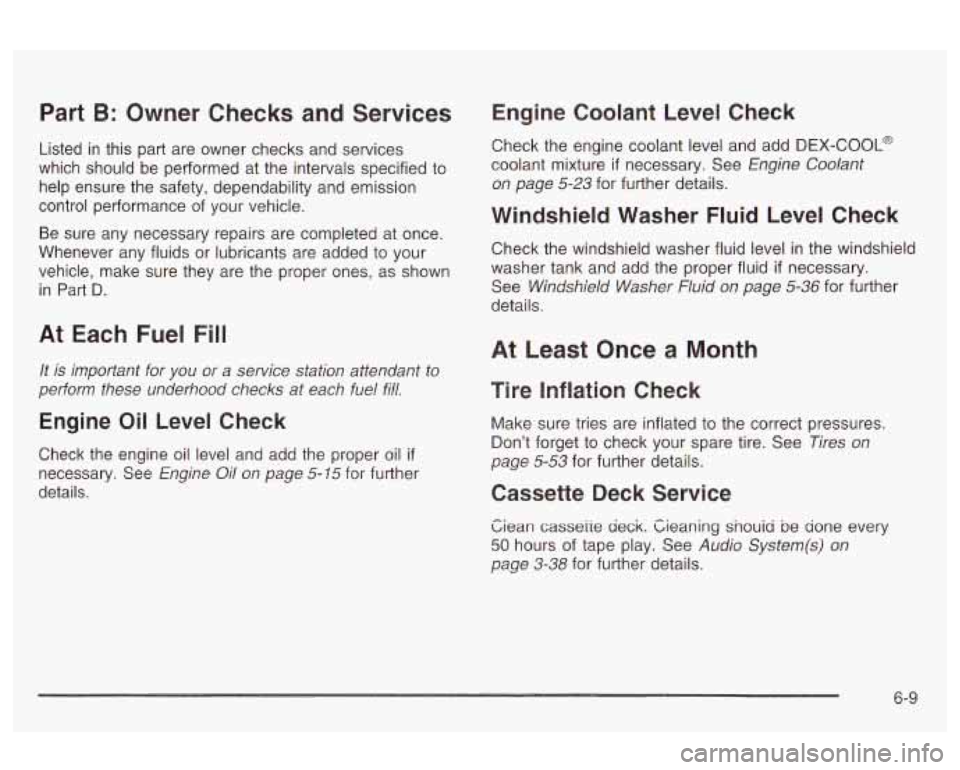
Part B: Owner Checks and Services
Listed in this part are owner checks and services
which should be performed at the intervals specified to
help ensure the safety, dependability and emission
control performance of your vehicle.
Be sure any necessary repairs are completed at once.
Whenever any fluids or lubricants are added to your
vehicle, make sure they are the proper ones, as shown
in Part
D.
At Each Fuel Fill
It is important for you or a service station attendant to
perform these Lmderhood checks at each fuel fil!.
Engine Oil Level Check
Check the engine oil level and add the proper oil if
necessary. See Engine Oil on page 5-15 for further
details.
Engine Coolant Level Check
Check the engine coolant level and add DEX-COOL@
coolant mixture
if necessary. See Engine Coolant
on page
5-23 for further details.
Windshield Washer Fluid Level Check
Check the windshield washer fluid level in the windshield
washer tank and add the proper fluid
if necessary.
See
Windshield Washer Fluid on page 5-36 for further
details.
At Least Once a Month
Tire Inreation Check
Make sure tries are inflated to the correct pressures.
Don’t forget to check your spare tire. See
Tires on
page 5-53 for further details.
Cassette Deck Service
Ziean casseiire deck. Zieaning snouid be done every
50 hours of tape play. See Audio System(s) on
page
3-38 for further details.
6-9
Page 336 of 354

Checking Engine Oil ........................................ 5-15
Checking Things Under the Hood
....................... 5-9
Checking Your Restraint Systems
...................... 1-60
Chemical Paint Spotting
................................... 5-78
Child Restraints Child Restraint Systems
............................... 1-38
Infants and Young Children
........................... 1-34
Lower Anchorages and Top Tethers for Children (LATCH System)
.......................... 1-43
Older Children
............................................. 1-32
Securing a Child Restraint Designed for the
LATCH System
........................................ 1-45
Securing a Child Restraint in a Center Rear
Seat Position
........................................... 1-48
Securing a Child Restraint in a Rear Outside
Seat
Position ........................................... 1=45
Securing a Child Restraint in the Right Front
Seat Position
........................................... 1-50
Top Strap
................................................... 1-41
Where to Put the Restraint
........................... 1-41
Chime Level Adjustment
.................................. 3-67
wyC4i t;llt; Llyr ilGl 4- IO
Cleaning Inside of Your Vehicle
........................... 5-72
Outside of Your Vehicle
................................ 5-75
Underbody Maintenance
............................... 5-78
Weatherstrips
.............................................. 5-75
Cleaning Exterior LampdLenses ....................... 5-76
Top Strap Anchor Location ............................ 1-42
P: -.--- IL- I :-.LA-- A +n .............................................
Climate Control System ................................... 3-19
Outlet Adjustment
........................................ 3-22
Compact Disc Messages
................. 3-42, 3-52, 3-64
Compact Spare Tire
........................................ 5-71
Control of a Vehicle
.......................................... 4-5
Coolant Engine Temperature Gage
............................ 3-31
Heater, Engine
............................................ 2-20
Low Warning Light
....................................... 3-31
Cooling System
.............................................. 5-28
Cruise Control
................................................ 3-10
Cruise Control Light
........................................ 3-36
Current and Past Model Order Forms
................ 7-11
Customer Assistance Information
Courtesy Transportation
.........
Customer Assistance for Text
Telephone (TTY) Users
............................... 7-3
Customer Assistance Offices
........................... 7-3
Customer Satisfaction Procedure
..................... 7-2
GM Mobility Proaram for Persons with
Disabilities
................................................ 7-5
Reporting Safety Defects to General Motors
...... 7-9
Reporting Safety Defects to the
Canadian Government
................................ 7-9
Reporting Safety Defects to the
United
States Gzvernment .... ....... 7-9
Clutch, Hydraulic ............................................. 5-22
Cupholder(s)
.................................................. 2-34
.............. 7-7
3